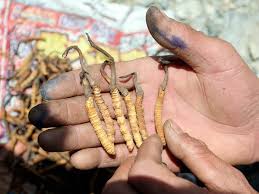From the BBC.
How much would you pay to eat a delicate fungus growing out of a dead caterpillar’s head? Considerably less than many Chinese aficionados, probably...
At a stall near the entrance of a grocery store in southern China, the shopper is greeted with delicate arrangements of dried objects. Lean in a little closer, and you'll see that they are inch-long dead caterpillars, with stalks growing out of their heads.
This may be the part of the country where people proudly claim that they'll eat anything with two legs that isn't a person and anything with four legs that isn't a table – the way Texans will brag about eating barbecue – but in this case, the caterpillars and their appendages are a nation-wide craze. They are gathered in Tibet and the Himalayas, and those stalks are fungi – Ophiocordyceps sinensis, to be exact – that take over their hosts, kill them, and then burst flamboyantly out of their heads.
These parasitic growths are interesting from a natural history perspective. But the reason they're arranged so carefully is that Chinese traditional medicine holds that they're good for just about anything from asthma to cancer.
They're also, perhaps more importantly, the kind of thing that cures low social status in the possessor, a trait shared in common with caviar and mink coats. And so they are estimated to sell for in excess of $20,000 (£16,000) per kilo, sometimes much, much more. That's at least 10 times the cost of black truffles.
The fantastic story of the caterpillars and their fungus begins thousands of miles away, where people spend each spring crawling on their hands and knees up mountainsides, looking for a tell-tale stalk. A remarkable telling of the caterpillar fungus's rise can be read over at National Geographic, where Michael Finkel wrote about going to Tibet to see the harvest for himself a few years ago. One couple he followed manages to sell their 30 hard-won “worms” for 580 RMB, or $90, but in the cities a pound of high-quality specimens can sell for $50,000 (£40,000), he writes.
People steep them in water by the ones and twos and put them in medicinal soups.
You don't need to eat that many, at least not all at once. People steep them in water by the ones and twos and put them in medicinal soups. It's still a considerable investment, with a quality worm or two coming out to something like $10-15 (£8 to £12). A pint of imported ice cream, a very pricey item in a Chinese grocery store, is about that much. The caterpillars are often sold alongside other trophy items, like sea cucumbers, whose popularity in China has led to sea cucumber gold rushes in other parts of the world that decimate their numbers.
Go.Smartbusinesschoices.com Flexible,affordable home business opportunity.



No comments:
Post a Comment